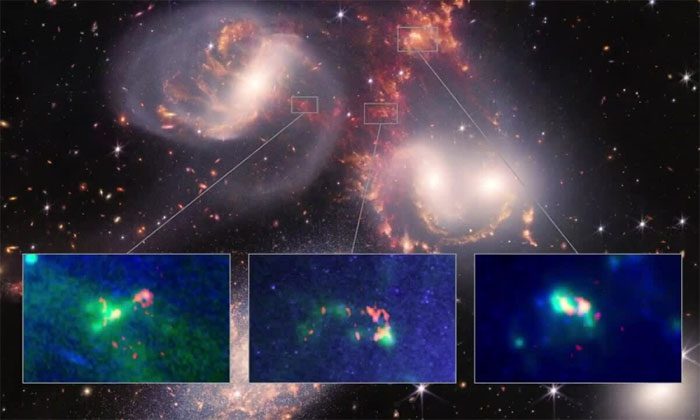Shockwaves Generated by Chaotic Collision in Pegasus Are Driving Strange Processes in the Intergalactic Environment.
Located approximately 270 million light-years from Earth, Stephan’s Quintet is a group of five colliding galaxies, where the original quartet NGC 7317, NGC 7318a, NGC 7319, and NGC 7320 form a physical link – meaning they are a true galaxy group with the potential to merge in the future – while the “intruder” NGC 7318b is barreling straight into the center of the group at speeds exceeding 2.9 million km/h (approximately 805 km/s).
This chaotic structure is considered an ideal laboratory for studying interactions between galaxies, including violent collision events and how these interactions affect their environments.
Recent observations made with the James Webb Space Telescope and the Atacama Large Millimeter/submillimeter Array (ALMA) in Chile have provided astronomers with clearer insights into what is happening within Stephan’s Quintet as the intruder NGC 7318b violently crashes into the galaxy quartet.
According to a report presented at the 241st meeting of the American Astronomical Society on January 9, this intense collision has generated shockwaves many times larger than the Milky Way, spreading through the interstellar plasma and activating “recycling factories” of warm and cold molecular hydrogen among the five galaxies of Stephan’s Quintet.

Shockwaves create “recycling factories” of molecular hydrogen in the Stephan’s Quintet galaxy group. (Video: P. Appleton/B. Saxton)
Additionally, Webb and ALMA discovered a massive gas cloud breaking apart to form a layer of “fog” of warm gas, which could result from the collision between two clouds or even the formation of a new galaxy.
“As the intruder crashes into the galaxy quartet, it collides with an old gas stream and creates gigantic shockwaves. As these shockwaves spread through space, they generate a highly chaotic cooling layer, and it is in the areas affected by this intense activity that we are observing unexpected structures and the recycling processes of molecular hydrogen. This is crucial because molecular hydrogen forms the raw material that could eventually lead to star formation. Understanding its fate will provide us insights into the evolution of Stephan’s Quintet and galaxies in general,” stated the lead author of the study, Philip Appleton, a senior scientist at the Infrared Processing and Analysis Center (IPAC) at the California Institute of Technology.
The new observations hold significant implications for theoretical models regarding the effects of turbulence in the universe. However, scientists still need to conduct further studies to understand the impact of high-level turbulence, as well as how warm and cold hydrogen gas forms a mixture.
Although the data from Webb and ALMA has provided substantial information about the relationship between the mixture of warm and cold hydrogen gas with ionized hydrogen gas caused by shockwaves, the research team will need to turn to spectral data for a complete understanding.
“Future spectral observations will tell us how fast the warm gas is moving, helping us measure the temperature of the hot gas and observe how it is cooled by shockwaves. Essentially, we have grasped one side of the story. Now it is time to explore the other side,” Appleton added.


















































